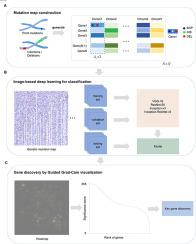Computational and Structural Biotechnology Journal ( IF 6 ) Pub Date : 2021-01-15 , DOI: 10.1016/j.csbj.2021.01.010 Taoyu Ye , Sen Li , Yang Zhang

|
Accurate cancer type classification based on genetic mutation can significantly facilitate cancer-related diagnosis. However, existing methods usually use feature selection combined with simple classifiers to quantify key mutated genes, resulting in poor classification performance. To circumvent this problem, a novel image-based deep learning strategy is employed to distinguish different types of cancer. Unlike conventional methods, we first convert gene mutation data containing single nucleotide polymorphisms, insertions and deletions into a genetic mutation map, and then apply the deep learning networks to classify different cancer types based on the mutation map. We outline these methods and present results obtained in training VGG-16, Inception-v3, ResNet-50 and Inception-ResNet-v2 neural networks to classify 36 types of cancer from 9047 patient samples. Our approach achieves overall higher accuracy (over 95%) compared with other widely adopted classification methods. Furthermore, we demonstrate the application of a Guided Grad-CAM visualization to generate heatmaps and identify the top-ranked tumor-type-specific genes and pathways. Experimental results on prostate and breast cancer demonstrate our method can be applied to various types of cancer. Powered by the deep learning, this approach can potentially provide a new solution for pan-cancer classification and cancer driver gene discovery. The source code and datasets supporting the study is available at https://github.com/yetaoyu/Genomic-pan-cancer-classification.
中文翻译:

使用基于图像的深度学习进行基因组全癌分类
基于基因突变的准确癌症类型分类可以显着促进癌症相关的诊断。但是,现有方法通常将特征选择与简单分类器结合使用以量化关键突变基因,导致分类性能不佳。为了解决这个问题,采用了一种基于图像的新型深度学习策略来区分不同类型的癌症。与传统方法不同,我们首先将包含单核苷酸多态性,插入和缺失的基因突变数据转换为遗传突变图,然后应用深度学习网络根据突变图对不同的癌症类型进行分类。我们概述了这些方法,并介绍了在训练VGG-16,Inception-v3,ResNet-50和Inception-ResNet-v2神经网络可从9047个患者样本中对36种癌症进行分类。与其他广泛采用的分类方法相比,我们的方法总体上具有更高的准确性(超过95%)。此外,我们演示了引导Grad-CAM可视化在生成热图和识别排名最高的肿瘤类型特异性基因和途径中的应用。在前列腺癌和乳腺癌上的实验结果表明,我们的方法可以应用于各种类型的癌症。在深度学习的支持下,这种方法可能为泛癌分类和癌症驱动基因的发现提供新的解决方案。支持这项研究的源代码和数据集可在https://github.com/yetaoyu/Genomic-pan-cancer-classification中找到。与其他广泛采用的分类方法相比,我们的方法总体上具有更高的准确性(超过95%)。此外,我们演示了引导Grad-CAM可视化在生成热图和识别排名最高的肿瘤类型特异性基因和途径中的应用。在前列腺癌和乳腺癌上的实验结果表明,我们的方法可以应用于各种类型的癌症。在深度学习的支持下,这种方法可能为泛癌分类和癌症驱动基因的发现提供新的解决方案。支持这项研究的源代码和数据集可在https://github.com/yetaoyu/Genomic-pan-cancer-classification中找到。与其他广泛采用的分类方法相比,我们的方法总体上具有更高的准确性(超过95%)。此外,我们演示了引导Grad-CAM可视化在生成热图和识别排名最高的肿瘤类型特异性基因和途径中的应用。在前列腺癌和乳腺癌上的实验结果表明,我们的方法可以应用于各种类型的癌症。在深度学习的支持下,这种方法可能为泛癌分类和癌症驱动基因的发现提供新的解决方案。支持这项研究的源代码和数据集可在https://github.com/yetaoyu/Genomic-pan-cancer-classification中找到。我们演示了引导Grad-CAM可视化在生成热图和识别排名最高的肿瘤类型特异性基因和途径中的应用。在前列腺癌和乳腺癌上的实验结果表明,我们的方法可以应用于各种类型的癌症。在深度学习的支持下,这种方法可能为泛癌分类和癌症驱动基因的发现提供新的解决方案。支持这项研究的源代码和数据集可在https://github.com/yetaoyu/Genomic-pan-cancer-classification中找到。我们演示了引导Grad-CAM可视化在生成热图和识别排名最高的肿瘤类型特异性基因和途径中的应用。在前列腺癌和乳腺癌上的实验结果表明,我们的方法可以应用于各种类型的癌症。在深度学习的支持下,这种方法可能为泛癌分类和癌症驱动基因的发现提供新的解决方案。支持这项研究的源代码和数据集可在https://github.com/yetaoyu/Genomic-pan-cancer-classification中找到。



























 京公网安备 11010802027423号
京公网安备 11010802027423号